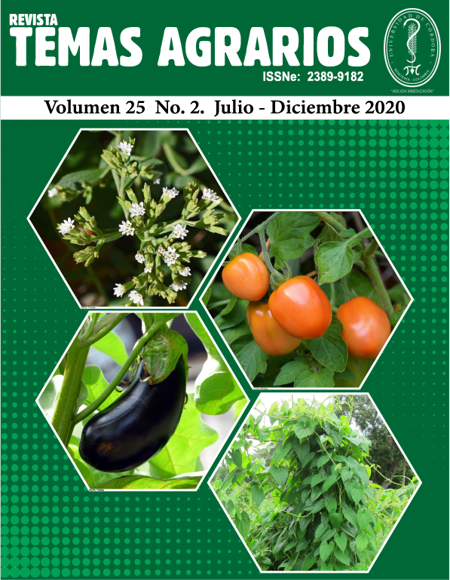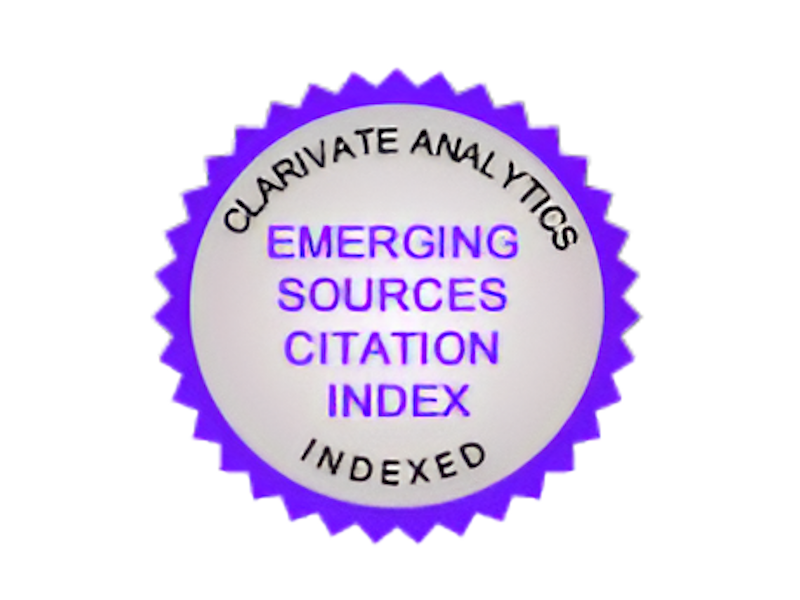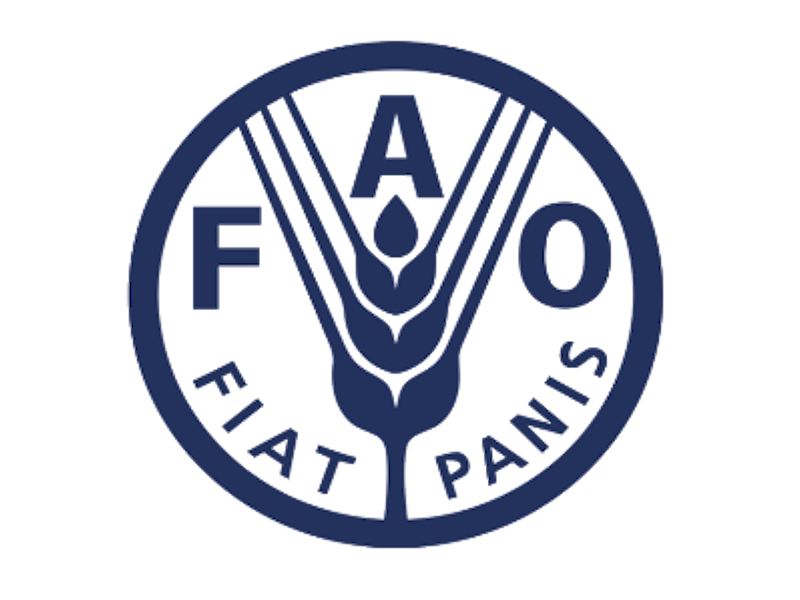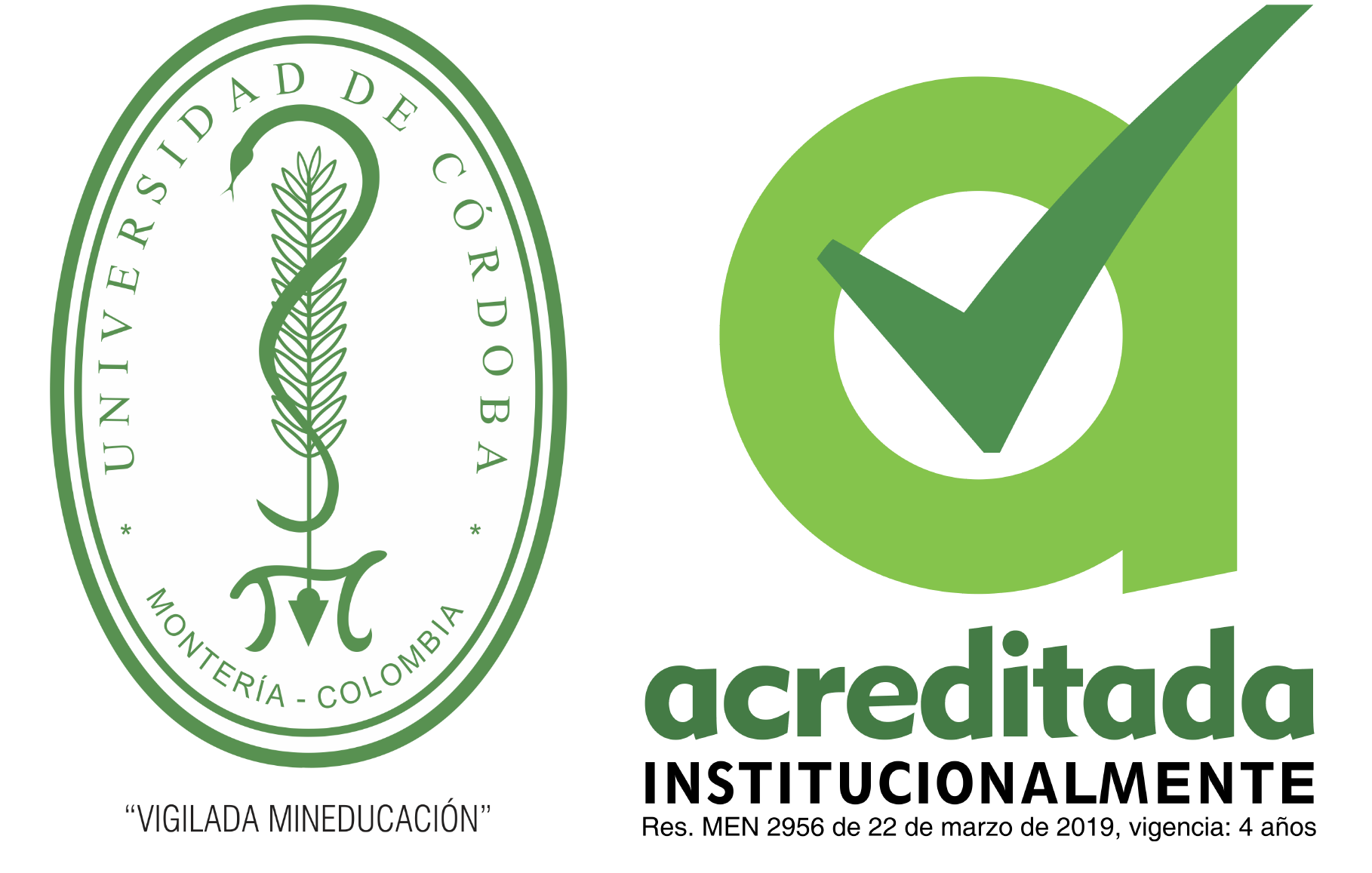Cambios fisiológicos y mecanismos genéticos asociados a la marchitez vascular causada por Fusarium en tomate: una revisión actualizada
Physiological and genetic changes associated to vascular wilt of tomato caused by Fusarium: an updated review

Esta obra está bajo una licencia internacional Creative Commons Atribución-NoComercial 4.0.
Mostrar biografía de los autores
El cultivo de tomate (Solanum lycopersicum), una de las hortalizas más cultivadas en el mundo, se enfrenta a diferentes patógenos del suelo que afectan su morfología, fisiología, bioquímica y regulación genética de las plantas. El hongo fitopatógeno Fusarium oxysporum f. sp. lycopersici (Fol) agente causal de la marchitez vascular del tomate causa pérdidas superiores al 60% en este cultivo. En esta revisión se presentan los mecanismos fisiológicos, bioquímicos y moleculares desarrollados en la interacción tomate – Fol. La co-evolución entre plantas y patógenos ha facilitado el desarrollo de mecanismos de defensa en las plantas que les permite protegerse frente a los efectos nocivos de la invasión por parte del patógeno, mientras que los patógenos implementan estrategias para imponerse frente a la resistencia de las plantas. Las consecuencias fisiológicas del ataque por Fol incluyen respuestas al déficit hídrico, regulaciones en la conductancia estomática, cambios en la fotosíntesis, así como alteraciones en los contenidos de clorofila y su fluorescencia. Estos cambios pueden ser explicados, en parte, con base en respuestas oxidativas, producción de metabolitos secundarios y activación de vías de señalización hormonales que hacen parte de una compleja red bioquímica activada tras la infección por el patógeno.
Visitas del artículo 1323 | Visitas PDF
Descargas
- Abbashar, A. M. 2003. Investigations On Fusarium oxysporum f. sp. lycopersici The Casual Agent Of Tomato Wilt (Lycopersicon esculentum Mill) (Issue March). University of Khartoum.
- Ádám, A., Nagy, Z., Kátay, G., Mergenthaler, E., and Viczián, O. 2018. Signals of Systemic Immunity in Plants: Progress and Open Questions. International Journal of Molecular Sciences, 19(4), 1146. https://doi.org/10.3390/ijms19041146
- Agronet. 2020. Base Agrícola EVA 2007-2019 (P)_12_02_2020.
- Akhter, A., Hage-Ahmed, K., Soja, G., and Steinkellner, S. 2015. Compost and biochar alter mycorrhization, tomato root exudation, and development of Fusarium oxysporum f. sp. lycopersici. Frontiers in Plant Science, 6, 529. https://doi.org/10.3389/fpls.2015.00529
- Alsamir, M., Mahmood, T., Ahmad, N., and Trethowan, R. 2017. Distribution of organic metabolites after Fusarium wilt incidence in tomato (Solanum esculentum L.). Australian Journal of Crop Science, 11(9): 1123–1129. https://doi.org/10.21475/ajcs.17.11.09.pne536
- Andersen, E., Ali, S., Byamukama, E., Yen, Y., and Nepal, M. 2018. Disease Resistance Mechanisms in Plants. Genes, 9(7): 339. https://doi.org/10.3390/genes9070339
- Arbona, V., Argamasilla, R., and Gómez-cadenas, A. 2010. Common and divergent physiological , hormonal and metabolic responses of Arabidopsis thaliana and Thellungiella halophila to water and salt stress. Journal of Plant Physiology, 167(16):1342–1350. https://doi.org/10.1016/j.jplph.2010.05.012
- Ashraf, M., and Foolad, M. R. 2007. Roles of glycine betaine and proline in improving plant abiotic stress resistance. Environmental and Experimental Botany, 59(2): 206–216. https://doi.org/10.1016/j.envexpbot.2005.12.006
- Atkinson, N., and Urwin, P. 2012. The interaction of plant biotic and abiotic stresses: from genes to the field. Journal of Experimental Botany, 63(10): 3523–3544. https://doi.org/10.1093/jxb/err313
- Azcón-Bieto, J., and Talón, M. 2008. Fundamentos de fisiología vegetal. In McGrawHill. https://doi.org/10.1017/CBO9781107415324.004
- Baker, N. R. 2008. Chlorophyll Fluorescence: A Probe of Photosynthesis In Vivo. Annual Review of Plant Biology, 59(1): 89–113. https://doi.org/10.1146/annurev.arplant.59.032607.092759
- Basco, M. J., Bisen, K., Keswani, C., y Singh, H. B. 2017. Biological management of Fusarium wilt of tomato using biofortified vermicompost. Mycosphere, 8(3): 467–483. https://doi.org/10.5943/mycosphere/8/3/8
- Beckers, G. J., and Conrath, U. 2007. Priming for stress resistance: from the lab to the field. Current Opinion in Plant Biology, 10(4): 425–431. https://doi.org/10.1016/J.PBI.2007.06.002
- Ben Rejeb, K., Abdelly, C., and Savouré, A. 2014. How reactive oxygen species and proline face stress together. Plant Physiology and Biochemistry, 80: 278–284. https://doi.org/10.1016/j.plaphy.2014.04.007
- Berger, S., Papadopoulos, M., Schreiber, U., Kaiser, W., and Roitsch, T. 2004. Complex regulation of gene expression, photosynthesis and sugar levels by pathogen infection in tomato. Physiologia Plantarum, 122(4): 419-428. https://doi.org/10.1111/j.1399-3054.2004.00433.x
- Boix-Ruíz, A., Gálvez-Patón, L., de Cara-García, M., Palmero-Llamas, D., Camacho-Ferre, F., and Tello-Marquina, J. C. 2015. Comparison of analytical techniques used to identify tomato-pathogenic strains of Fusarium oxysporum. Phytoparasitica, 43(4): 471-483. https://doi.org/10.1007/s12600-014-0444-z
- Boller, T., and Felix, G. 2009. A renaissance of elicitors: perception of microbe-associated molecular patterns and danger signals by pattern-recognition receptors. Annual Review of Plant Biology, 60, 379–406. https://doi.org/10.1146/annurev.arplant.57.032905.105346
- Brodersen, C. R., and McElrone, A. J. 2013. Maintenance of xylem Network Transport Capacity: A Review of Embolism Repair in Vascular Plants. Frontiers in Plant Science, 4, 108. https://doi.org/10.3389/fpls.2013.00108
- Carvalhais, L. C., Dennis, P. G., Badri, D. V., Tyson, G. W., Vivanco, J. M., and Schenk, P. M. 2013. Activation of the Jasmonic Acid Plant Defence Pathway Alters the Composition of Rhizosphere Bacterial Communities. PLoS ONE, 8(2): 1–5. https://doi.org/10.1371/journal.pone.0056457
- Catanzariti, A. M., Do, H. T. T., Bru, P., de Sain, M., Thatcher, L. F., Rep, M., y Jones, D. A. 2017. The tomato I gene for Fusarium wilt resistance encodes an atypical leucine-rich repeat receptor-like protein whose function is nevertheless dependent on SOBIR1 and SERK3/BAK1. Plant Journal, 89(6): 1195–1209. https://doi.org/10.1111/tpj.13458
- Chaudhary, R., and Atamian, H. 2017. Resistance-Gene-Mediated Defense Responses against Biotic Stresses in the Crop Model Plant Tomato. Journal of Plant Pathology & Microbiology, 8(4): 1–11. https://doi.org/10.4172/2157-7471.1000404
- Chaves, M. M., Flexas, J., and Pinheiro, C. 2009. Photosynthesis under drought and salt stress: Regulation mechanisms from whole plant to cell. Annals of Botany, 103(4): 551–560. https://doi.org/10.1093/aob/mcn125
- Chekali, S., Gargouri, S., Paulitz, T., Nicol, J. M., Rezgui, M., and Nasraoui, B. 2011. Effects of Fusarium culmorum and water stress on durum wheat in Tunisia. Crop Protection, 30(6), 718–725. https://doi.org/10.1016/j.cropro.2011.01.007
- Choudhary, D. K., and Varma, A. 2016. Microbial-mediated Induced Systemic Resistance in Plants (D. K. Choudhary & A. Varma (Eds.); 1st ed.). Springer India.
- Clayton, E. E. 1923. The Relation of Temperature to the Fusarium Wilt of the Tomato. American Journal of Botany, 10(2): 71. https://doi.org/10.2307/2435575
- Cole, S. J., Yoon, A. J., Faull, K. F., and Diener, A. C. 2014. Host perception of jasmonates promotes infection by Fusarium oxysporum formae speciales that produce isoleucine- and leucine-conjugated jasmonates. Molecular Plant Pathology, 15(6): 589–600. https://doi.org/10.1111/mpp.12117
- Constantin, M. E., de Lamo, F. J., Vlieger, B. V., Rep, M., and Takken, F. L. W. 2019. Endophyte-Mediated Resistance in Tomato to Fusarium oxysporum Is Independent of ET, JA, and SA. Frontiers in Plant Science, 10, 1–14. https://doi.org/10.3389/fpls.2019.00979
- Couto, D., and Zipfel, C. 2016. Regulation of pattern recognition receptor signalling in plants. Nature Reviews Immunology, 16(9): 537–552. https://doi.org/10.1038/nri.2016.77
- Dean, R., Van Kan, J. A. L., Pretorius, Z. A., Hammond-kosack, K. E., Di Pietro, A., Spanu, P. D., Rudd, J. J., Dickman, M., Kahmann, R., Ellis, J., and Foster, G. D. 2012. The Top 10 fungal pathogens in molecular plant pathology. Molecular Plant Pathology, 13(4): 414-430. https://doi.org/10.1111/j.1364-3703.2011.00783.x
- Dehgahi, R., Subramaniam, S., Zakaria, L., Joniyas, A., Firouzjahi, F. B., Haghnama, K., and Razinataj, M. 2015. Review of Research on Fungal Pathogen Attack and Plant Defense Mechanism against Pathogen. International Journal of Scientific Research in Agricultural Sciences, 2(8): 197–208. https://doi.org/10.12983/ijsras-2015-p0197-0208
- Di Pietro, A., Madrid, M. P., Caracuel, Z., Delgado-Jarana, J., and Roncero, M. I. G. 2003. Fusarium oxysporum: Exploring the molecular arsenal of a vascular wilt fungus. Molecular Plant Pathology, 4(5): 315–325. https://doi.org/10.1046/j.1364-3703.2003.00180.x
- Di, X., Gomila, J. O., and Takken, F. L. W. 2017. Involvement of salicylic acid , ethylene and jasmonic acid signalling pathways in the susceptibility of tomato to Fusarium oxysporum. Molecular Plant Pathology, 18(7): 1024–1035.
- Dmitriev, a P. 2003. Signal Molecules for Plant Defense Responses to Biotic Stress. Text, 50(3): 417-425.
- Doares, S. H., Syrovetst, T., Weilert, E. W., and Ryan, C. A. 1995. Oligogalacturonides and chitosan activate plant defensive genes through the octadecanoid pathway. 92, 4095-4098. http://www.pnas.org/content/pnas/92/10/4095.full.pdf
- Dong, X., Xiong, Y., Ling, N., Shen, Q., y Guo, S. 2014. Fusaric acid accelerates the senescence of leaf in banana when infected by Fusarium. World Journal of Microbiology and Biotechnology, 30(4): 1399–1408. https://doi.org/10.1007/s11274-013-1564-1
- Duniway, J. 1971. Water relations of Fusarium wilt. Physiology Plant Pathology, 1, 539–548.
- FAO. 2020. Faostat: Production quantities of Tomatoes by country.
- Fraire-Velázquez, S., Rodríguez-Guerra, R., y Sánchez-Calderón, L. 2011. Abiotic and Biotic Stress Response Crosstalk in Plants. In A. Shank (Ed.), Abiotic Stress Response in Plants - Physiological, Biochemical and Genetic Perspectives (InTech Eur, p. 346).
- Francia, D., Demaria, D., Calderini, O., Ferraris, L., Valentino, D., Arcioni, S., Tamietti, G., and Cardinale, F. 2007. Wounding induces resistance to pathogens with different lifestyles in tomato: Role of ethylene in cross-protection. Plant, Cell and Environment, 30(11): 1357–1365. https://doi.org/10.1111/j.1365-3040.2007.01709.x
- Freitas De Campos, M., Carvalho, K. De, Suano, F., Souza, D., and Jamil, C. 2011. Drought tolerance and antioxidant enzymatic activity in transgenic ‘ Swingle ’citrumelo plants over-accumulating proline. Environmental and Experimental Botany, 72, 242–250. https://doi.org/10.1016/j.envexpbot.2011.03.009
- García-Enciso, E. L., Benavides-Mendoza, A., Flores-López, M. L., Robledo-Olivo, A., Juárez-Maldonado, A., and González-Morales, S. 2018. A Molecular Vision of the Interaction of Tomato Plants and Fusarium oxysporum f. sp. lycopersic. In Fusarium - Plant Diseases, Pathogen Diversity, Genetic Diversity, Resistance and Molecular Markers. InTech.
- https://doi.org/10.5772/intechopen.72127
- Goltsev, V. N., Kalaji, H. M., Paunov, M., Bąba, W., Horaczek, T., Mojski, J., Kociel, H., and Allakhverdiev, S. I. 2016. Variable chlorophyll fluorescence and its use for assessing physiological condition of plant photosynthetic apparatus. Russian Journal of Plant Physiology, 63(6), 869–893. https://doi.org/10.1134/S1021443716050058
- Gonzalez-Cendales, Y., Catanzariti, A.-M., Baker, B., Mcgrath, D. J., and Jones, D. A. 2016. Identification of I-7 expands the repertoire of genes for resistance to Fusarium wilt in tomato to three resistance gene classes. Molecular Plant Pathology, 17(3): 448–463. https://doi.org/10.1111/mpp.12294
- Henry, G., Thonart, P., and Ongena, M. 2012. PAMPs, MAMPs, DAMPs and others: an update on the diversity of plant immunity elicitors. Biotechnologie, Agronomie, Société et, 16(2), 12.
- Houterman, P. M., Cornelissen, B. J. C., and Rep, M. 2008. Suppression of plant resistance gene-based immunity by a fungal effector. PLoS Pathogens, 4(5):1–6. https://doi.org/10.1371/journal.ppat.1000061
- Huot, B., Yao, J., Montgomery, B. L., and He, S. Y. 2014. Growth-defense tradeoffs in plants: A balancing act to optimize fitness. Molecular Plant, 7(8): 1267–1287. https://doi.org/10.1093/mp/ssu049
- Inami, K., Yoshioka-Akiyama, C., Morita, Y., Yamasaki, M., Teraoka, T., and Arie, T. 2012. A Genetic Mechanism for Emergence of Races in Fusarium oxysporum f. sp. lycopersici: Inactivation of Avirulence Gene AVR1 by Transposon Insertion. PLoS ONE, 7(8), e44101. https://doi.org/10.1371/journal.pone.0044101
- Ishikawa, R., Shirouzu, K., Nakashita, H., Lee, H. Y., Motoyama, T., Yamaguchi, I., Teraoka, T., and Arie, T. 2005. Foliar spray of validamycin A or validoxylamine A controls tomato fusarium wilt. Phytopathology, 95(10): 1209–1216. https://doi.org/10.1094/PHYTO-95-1209
- Ito, S. ichi, Ihara, T., Tamura, H., Tanaka, S., Ikeda, T., Kajihara, H., Dissanayake, C., Abdel-Motaal, F. F., and El-Sayed, M. A. 2007. α-Tomatine, the major saponin in tomato, induces programmed cell death mediated by reactive oxygen species in the fungal pathogen Fusarium oxysporum. FEBS Letters, 581(17): 3217–3222. https://doi.org/10.1016/j.febslet.2007.06.010
- Jayamohan, N. S., Patil, S. V., and Kumudini, B. S. 2018. Reactive oxygen species (ROS) and antioxidative enzyme status in Solanum lycopersicum on priming with fluorescent Pseudomonas spp. against Fusarium oxysporum. Biologia, 73(11): 1073–1082. https://doi.org/10.2478/s11756-018-0125-3
- Jiao, J., Zhou, B., Zhu, X., Gao, Z., y Liang, Y. 2013. Fusaric acid induction of programmed cell death modulated through nitric oxide signalling in tobacco suspension cells. Planta, 238(4): 727–737. https://doi.org/10.1007/s00425-013-1928-7
- Jogaiah, S., Abdelrahman, M., Tran, L. S. P., y Ito, S. I. 2018. Different mechanisms of Trichoderma virens-mediated resistance in tomato against Fusarium wilt involve the jasmonic and salicylic acid pathways. Molecular Plant Pathology, 19(4): 870–882. https://doi.org/10.1111/mpp.12571
- Jones, D., and Takemoto, D. 2004. Plant innate immunity - direct and indirect recognition of general and specific pathogen-associated molecules. Current Opinion in Immunology, 16(1): 48–62. https://doi.org/10.1016/j.coi.2003.11.016
- Jones, J. D. G., y Dangl, J. L. 2006. The plant immune system. Nature Reviews, 444, 323–329. https://doi.org/10.1038/nature05286
- Jones, J. D. G., Vance, R. E., and Dangl, J. L. 2016. Intracellular innate immune surveillance devices in plants and animals. In Science 354 (6316): 1-8. American Association for the Advancement of Science. https://doi.org/10.1126/science.aaf6395
- Kavroulakis, N., Doupis, G., Papadakis, I. E., Ehaliotis, C., and Papadopoulou, K. K. 2018. Tolerance of tomato plants to water stress is improved by the root endophyte Fusarium solani FsK. Rhizosphere, 6, 77–85. https://doi.org/10.1016/j.rhisph.2018.04.003
- Kavroulakis, N., Ntougias, S., Zervakis, G. I., Ehaliotis, C., Haralampidis, K., and Papadopoulou, K. K. 2007. Role of ethylene in the protection of tomato plants against soil-borne fungal pathogens conferred by an endophytic Fusarium solani strain. Journal of Experimental Botany, 58(14): 3853–3864. https://doi.org/10.1093/jxb/erm230
- Kiirika, L. M., Stahl, F., and Wydra, K. 2013. Phenotypic and molecular characterization of resistance induction by single and combined application of chitosan and silicon in tomato against Ralstonia solanacearum. Physiological and Molecular Plant Pathology, 81, 1–12. https://doi.org/10.1016/j.pmpp.2012.11.002
- Król, P., Igielski, R., Pollmann, S., and Kepczyńska, E. 2015. Priming of seeds with methyl jasmonate induced resistance to hemi-biotroph Fusarium oxysporum f.sp. lycopersici in tomato via 12-oxo-phytodienoic acid, salicylic acid, and flavonol accumulation. Journal of Plant Physiology, 179, 122–132. https://doi.org/10.1016/j.jplph.2015.01.018
- Kumar, A., and Verma, J. P. 2018. Does plant Microbe interaction confer stress tolerance in plants: A review? Microbiological Research, 207, 41–52. https://doi.org/10.1016/j.micres.2017.11.004
- Latowski, D., Surówka, E., and Strzałka, K. 2010. Regulatory Role of Components of Ascorbate Glutathione Pathway in Plant Stress Tolerance. In N. A. Anjum, S. Umar, & M.-T. Chan (Eds.), Ascorbate-Glutathione Pathway and Stress Tolerance in Plants. 1-443. Springer Netherlands. https://doi.org/10.1007/978-90-481-9404-9
- Liu, L., Sonbol, F. M., Huot, B., Gu, Y., Withers, J., Mwimba, M., Yao, J., He, S. Y., and Dong, X. 2016. Salicylic acid receptors activate jasmonic acid signalling through a non-canonical pathway to promote effector-triggered immunity. Nature Communications, 7, 1–10. https://doi.org/10.1038/ncomms13099
- López-Díaz, C., Rahjoo, V., Sulyok, M., Ghionna, V., Martín-Vicente, A., Capilla, J., Di Pietro, A., and López-Berges, M. S. 2017. Fusaric acid contributes to virulence of Fusarium oxysporum on plant and mammalian hosts. Molecular Plant Pathology. https://doi.org/10.1111/mpp.12536
- Lorenzini, G., Guidi, L., Nali, C., Ciompi, S., and Soldatini, G. F. 1997. Photosynthetic response of tomato plants to vascular wilt diseases. Plant Science, 124(2): 143–152. https://doi.org/10.1016/S0168-9452(97)04600-1
- Lund, S. T., Stall, R. E., and Klee, H. J. 1998. Ethylene regulates the susceptible response to pathogen infection in tomato. Plant Cell, 10(3): 371–382. https://doi.org/10.1105/tpc.10.3.371
- Lushchak, V. I. 2011. Adaptive response to oxidative stress: Bacteria, fungi, plants and animals. Comparative Biochemistry and Physiology Part C: Toxicology & Pharmacology, 153(2): 175–190. https://doi.org/10.1016/j.cbpc.2010.10.004
- Maina, F. M., Hauschild, R., and Sikora, R. 2008. Protection of tomato plants against fusaric acid by resistance induction. In ©Journal of Applied Biosciences.1 (1). www.biosciences.elewa.org
- Mandal, S., Mallick, N., and Mitra, A. 2009. Salicylic acid-induced resistance to Fusarium oxysporum f. sp. lycopersici in tomato. Plant Physiology and Biochemistry, 47(7):642–649. https://doi.org/10.1016/j.plaphy.2009.03.001
- Manokaran, R., and Jambhulkar, P. P. 2016. Study of induced systemic resistance in tomato against Fusarium oxysporum f. sp lycopersici causing wilt of tomato Study of induced systemic resistance in tomato against Fusarium oxysporum f. sp lycopersici causing wilt of tomato. 69, 539–542.
- Maqsood, A., Wu, H., Kamran, M., Altaf, H., Mustafa, A., Ahmar, S., Hong, N. T. T., Tariq, K., He, Q., and Chen, J. T. 2020. Variations in growth, physiology, and antioxidative defense responses of two tomato (Solanum lycopersicum L.) cultivars after co-infection of Fusarium oxysporum and Meloidogyne incognita. Agronomy, 10(2):1-25.
- https://doi.org/10.3390/agronomy10020159
- Marín-Ortiz, J. C., Gutierrez-Toro, N., Botero-Fernández, V., and Hoyos-Carvajal, L. M. 2020. Linking physiological parameters with visible/near-infrared leaf reflectance in the incubation period of vascular wilt disease. Saudi Journal of Biological Sciences, 27(1): 88–99. https://doi.org/10.1016/j.sjbs.2019.05.007
- Martínez-Medina, A., Fernández, I., Sánchez-Guzmán, M. J., Jung, S. C., Pascual, J. A., and Pozo, M. J. 2013. Deciphering the hormonal signalling network behind the systemic resistance induced by Trichoderma harzianum in tomato. Frontiers in Plant Science, 4, 1–12. https://doi.org/10.3389/fpls.2013.00206
- Maxwell, K., and Johnson, G. N. 2000. Chlorophyll a fluorescence - a practical guide. Journal of Experimental Botany, 51(345): 659–668. https://doi.org/10.1093/jxb/51.345.659
- McGovern, R. J. 2015. Management of tomato diseases caused by Fusarium oxysporum. Crop Protection, 73, 78–92.
- https://doi.org/10.1016/j.cropro.2015.02.021
- Melgarejo, L. M., Romero, M., Hernandez, S., Barrera, J., Solarte, E., Pérez, V., Rojas, A., Cruz, M., Moreno, L., Crespo, S., and Pérez, W. 2010. Experimentos en Fisiología Vegetal (U. N. de Colombia (Ed.); First edit). Universidad Nacional de Colombia.
- Mes, J. J., Van Doorn, A. A., Wijbrandi, J., Simons, G., Cornelissen, B. J. C., and Haring, M. A. 2000. Expression of the Fusarium resistance gene I-2 colocalizes with the site of fungal containment. Plant Journal, 23(2), 183–193. https://doi.org/10.1046/j.1365-313X.2000.00765.x
- Michielse, C. B., and Rep, M. 2009. Pathogen profile update: Fusarium oxysporum. Molecular Plant Pathology, 10(3): 311-324. https://doi.org/10.1111/j.1364-3703.2009.00538.x
- Nair, A., Kolet, S. P., Thulasiram, H. V., and Bhargava, S. 2015. Role of methyl jasmonate in the expression of mycorrhizal induced resistance against Fusarium oxysporum in tomato plants. Physiological and Molecular Plant Pathology, 92, 139–145. https://doi.org/10.1016/j.pmpp.2015.10.002
- Nankishore, A., and Farrell, A. D. 2016. The response of contrasting tomato genotypes to combined heat and drought stress. Journal of Plant Physiology, 202, 75–82. https://doi.org/10.1016/j.jplph.2016.07.006
- Narasimhamurthy, K., Soumya, K., Udayashankar, A. C., Srinivas, C., and Niranjana, S. R. 2019. Elicitation of innate immunity in tomato by salicylic acid and Amomum nilgiricum against Ralstonia solanacearum. Biocatalysis and Agricultural Biotechnology, 22. 1-7. https://doi.org/10.1016/j.bcab.2019.101414
- Nobori, T., Mine, A., and Tsuda, K. 2018. Molecular networks in plant-pathogen holobiont. FEBS Letters.
- https://doi.org/10.1002/1873-3468.13071
- Nogués, S., Cotxarrera, L., Alegre, L., and Trillas, M. I. 2002. Limitations to photosynthesis in tomato leaves induced by Fusarium wilt. New Phytologist, 154(2): 461–470. https://doi.org/10.1046/j.1469-8137.2002.00379.x
- Periyannan, S., Milne, R. J., Figueroa, M., Lagudah, E. S., and Dodds, P. N. 2017. An overview of genetic rust resistance: From broad to specific mechanisms. In PLoS Pathogens 13(7). Public Library of Science. https://doi.org/10.1371/journal.ppat.1006380
- Pieterse, C. M. J., Leon-Reyes, A., van Der Ent, S., and van Wees, S. C. M. 2009. Networking by small-molecule hormones in plant immunity. Nature Chemical Biology, 5(5): 308–316. https://doi.org/10.1038/nchembio.164
- Pieterse, C. M. J., van der Does, D., Zamioudis, C., Leon-Reyes, A., and Van Wees, S. C. M. 2012. Hormonal Modulation of Plant Immunity. Annual Review of Cell and Developmental Biology, 28(1): 489–521. https://doi.org/10.1146/annurev-cellbio-092910-154055
- Pinheiro, C., and Chaves, M. M. 2011. Photosynthesis and drought: Can we make metabolic connections from available data? Journal of Experimental Botany, 62(3): 869–882. https://doi.org/10.1093/jxb/erq340
- Pitzschke, A., Schikora, A., and Hirt, H. 2009. MAPK cascade signalling networks in plant defence. Current Opinion in Plant Biology, 12(4): 421–426. https://doi.org/10.1016/j.pbi.2009.06.008
- Pshibytko, N. L., Zenevich, L. A., and Kabashnikova, L. F. 2006. Changes in the photosynthetic apparatus during Fusarium wilt of tomato. Russian Journal of Plant Physiology, 53(1): 25–31.
- Pusztahelyi, T. 2018. Chitin and chitin-related compounds in plant–fungal interactions. Mycology, 9(3): 189–201.
- https://doi.org/10.1080/21501203.2018.1473299
- Qi, J., Song, C. P., Wang, B., Zhou, J., Kangasjärvi, J., Zhu, J. K., and Gong, Z. 2018. Reactive oxygen species signaling and stomatal movement in plant responses to drought stress and pathogen attack. Journal of Integrative Plant Biology, 60(9): 805–826. https://doi.org/10.1111/jipb.12654
- Ramírez-Gómez, M., and Rodríguez, A. 2012. Mecanismos de defensa y respuestas de las plantas en la interacción micorrícica: una revisión. Revista Colombiana de Biotecnología, 14(1): 271–284.
- Rep, M., van Der Does, H. C., Meijer, M., Van Wijk, R., Houterman, P. M., Dekker, H. L., De Koster, C. G., and Cornelissen, B. J. C. 2004. A small, cysteine-rich protein secreted by Fusarium oxysporum during colonization of xylem vessels is required for I-3-mediated resistance in tomato. Molecular Microbiology, 53(5): 1373-1383. https://doi.org/10.1111/j.1365-2958.2004.04177.x
- Saharan, V., and Pal, A. 2016. Chitosan Based Nanomaterials in Plant Growth and Protection. Springer India.
- Samadi, L., and Behboodi, B. 2006. Fusaric acid induces apoptosis in saffron root-tip cells: roles of caspase-like activity, cytochrome c, and H2O2. Planta, 225(1), 223–234. https://doi.org/10.1007/s00425-006-0345-6
- Shah, J. 2009. Plants under attack: systemic signals in defence. Current Opinion in Plant Biology, 12(4): 459–464.
- https://doi.org/10.1016/j.pbi.2009.05.011
- Sharif, R., Mujtaba, M., Rahman, M. U., Shalmani, A., Ahmad, H., Anwar, T., Tianchan, D., and Wang, X. 2018. The Multifunctional Role of Chitosan in Horticultural crops: a review. Molecules, 23(872): 1–20. https://doi.org/10.3390/molecules23040872
- Singh, P., Singh, J., Ray, S., Rajput, R. S., Vaishnav, A., Singh, R. K., and Singh, H. B. 2020. Seed biopriming with antagonistic microbes and ascorbic acid induce resistance in tomato against Fusarium wilt Prachi. Microbiological Research, 237. https://doi.org/10.1016/j.micres.2020.126482
- Singh, V. K., Singh, H. B., and Upadhyay, R. S. 2017. Role of fusaric acid in the development of ‘Fusarium wilt’ symptoms in tomato: Physiological, biochemical and proteomic perspectives. Plant Physiology and Biochemistry, 118, 320–332.
- https://doi.org/10.1016/j.plaphy.2017.06.028
- Singh, V. K., and Upadhyay, R. S. 2014. Fusaric acid induced cell death and changes in oxidative metabolism of Solanum lycopersicum L. Botanical Studies, 55(1): 66. https://doi.org/10.1186/s40529-014-0066-2
- Soliman, M. H., and El-Mohamedy, R. S. R. 2017. Induction of defense-related physiological and antioxidant enzyme response against powdery mildew disease in okra (Abelmoschus esculentus L.) plant by using chitosan and potassium salts. Mycobiology. https://doi.org/10.5941/MYCO.2017.45.4.409
- Srinivas, C., Nirmala Devi, D., Narasimha Murthy, K., Mohan, C. D., Lakshmeesha, T. R., Singh, B. P., Kalagatur, N. K., Niranjana, S. R., Hashem, A., Alqarawi, A. A., Tabassum, B., Abd Allah, E. F., and Chandra Nayaka, S. 2019. Fusarium oxysporum f. sp. lycopersici causal agent of vascular wilt disease of tomato: Biology to diversity A review. Saudi Journal of Biological Sciences, 26(7): 1315–1324. https://doi.org/10.1016/j.sjbs.2019.06.002
- Stahl, E., biology, J. B.-C. opinion in plant, and 2000. Plant pathogen arms races at the molecular level. Plant Bioloy. 3(4):299-304. Doi: 10.1016/s1369-5266(00)00083-2
- Takken, F., and Rep, M. 2010. The arms race between tomato and Fusarium oxysporum. In Molecular Plant Pathology 11(2):309–314. https://doi.org/10.1111/j.1364-3703.2009.00605.x
- Thaler, J. S., Humphrey, P. T., and Whiteman, N. K. 2012. Evolution of jasmonate and salicylate signal crosstalk. Trends in Plant Science, 17(5):260–270. https://doi.org/10.1016/j.tplants.2012.02.010
- Tripathy, B. C. hara., and Oelmüller, R. 2012. Reactive oxygen species generation and signaling in plants. Plant Signaling & Behavior, 7(12): 1621–1633. https://doi.org/10.4161/psb.22455
- Van der Does, H. C., Constantin, M. ., Houterman, P. M., Takken, F. L. W., Cornelissen, B. J. C., Haring, M. A., van den Burg, H. A., and Rep, M. 2018. Fusarium oxysporum colonizes the stem of resistant tomato plants , the extent varying with the R-gene present. European Journal of Plant Pathology, 154. 55-65.
- Van Loon, L. C., Rep, M., and Pieterse, C. M. J. 2006. Significance of Inducible Defense-related Proteins in Infected Plants. Annual Review of Phytopathology, 44(1), 135–162. https://doi.org/10.1146/annurev.phyto.44.070505.143425
- Vidhyasekaran, P. 2016. Switching on Plant Innate Immunity Signaling Systems - Bioengineering and Molecular Manipulation of PAMP-PIMP-PRR Signaling Complex (F. Baluška & J. Vivanco (Eds.)). Springer International Publishing AG Switzerland. https://doi.org/10.1007/978-3-319-26118-8
- Villa-Martínez, A., Morales-morales, Hugo Armando., Pérez-Leal, R., y Soto-parra, Juan Manuel., Basurto-Sotelo, M. and E. M.-E. 2015. Situación actual en el control de Fusarium spp . y evaluación de la actividad antifúngica de extractos vegetales. Acta Agronomica, 64(2): 194-205. https://doi.org/http://dx.doi.org/10.15446/acag.v64n2.43358
- Villarreal, A. del P. 2013. Evaluación fisiológica de plantas de uchuva (Physalis peruviana L.), en la respuesta al estrés por anegamiento e infección de Fusarium oxysporum. 141.
- Wagner, A., Michalek, W., and Jamiolkowska, A. 2006. Chlorophyll fluorescence measurements as indicators of fusariosis severity in tomato plants. Agronomy Research, 4(Speciel Issue), 461–464.
- Walters, D. R. 2015. Physiological responses of plants to attack. In Crop & Soil Systems Research Group (Wiley Blac),1. 248
- Walters, M. 2015. The plant innate immune system. Journal of Endocytobiosis and Cell Research, 26, 8–12.
- Wang, F., Wu, N., Zhang, L., Ahammed, G. J., Chen, X., Xiang, X., Zhou, J., Xia, X., Shi, K., Yu, J., Foyer, C. H., and Zhou, Y. 2018. Light Signaling-dependent Regulation of Photoinhibition and Photoprotection in Tomato. Plant Physiology, 176, 1311–1326. https://doi.org/10.1104/pp.17.01143
- Wiesel, L., Newton, A. C., Elliott, I., Booty, D., Gilroy, E. M., Birch, P. R. J., and Hein, I. 2014. Molecular effects of resistance elicitors from biological origin and their potential for crop protection. Frontiers in Plant Science, 5, 655.
- https://doi.org/10.3389/fpls.2014.00655
- Yadeta, K. A., and J. Thomma, B. P. H. 2013. The xylem as battleground for plant hosts and vascular wilt pathogens. Frontiers in Plant Science, 4, 1–12. https://doi.org/10.3389/fpls.2013.00097
- Yang, F., Wang, Y., Wang, J., Deng, W., Liao, L., and Li, M. 2011. Different eco-physiological responses between male and female Populus deltoides clones to waterlogging stress. Forest Ecology and Management, 262(11): 1963–1971.
- https://doi.org/10.1016/j.foreco.2011.08.039
- Zaynab, M., Fatima, M., Abbas, S., Sharif, Y., Umair, M., Zafar, M. H., and Bahadar, K. 2018. Role of secondary metabolites in plant defense against pathogens. In Microbial Pathogenesis 124, 198–202. Academic Press. https://doi.org/10.1016/j.micpath.2018.08.034
- Zehra, A., Meena, M., Dubey, M. K., Aamir, M., and Upadhyay, R. S. 2017. Synergistic effects of plant defense elicitors and Trichoderma harzianum on enhanced induction of antioxidant defense system in tomato against Fusarium wilt disease. Botanical Studies, 58(1). https://doi.org/10.1186/s40529-017-0198-2
- Zhang, H., Zhang, Q., Zhai, H., Gao, S., Yang, L., Wang, Z., Xu, Y., Huo, J., Ren, Z., Zhao, N., Wang, X., Li, J., Liu, Q., and He, S. 2020. IbBBX24 Promotes the Jasmonic Acid Pathway and Enhances Fusarium Wilt Resistance in Sweet Potato. The Plant Cell, tpc.00641.2019. https://doi.org/10.1105/tpc.19.00641




















